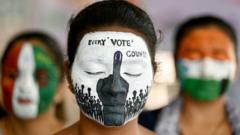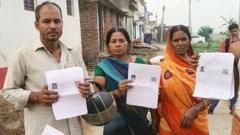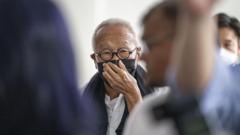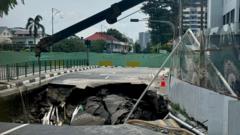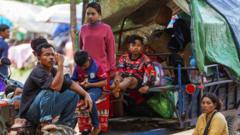The People's Action Party (PAP) seeks to revitalize its image and attract a younger demographic through innovative social media strategies.
**Singapore's PAP Embraces Social Media to Engage Younger Voters Ahead of Election**
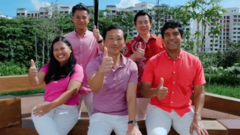
**Singapore's PAP Embraces Social Media to Engage Younger Voters Ahead of Election**
Singapore's ruling party adapts to a modern electorate with targeted digital campaigns aimed at youth participation.
In a vibrant push to connect with Singapore's youth, the People's Action Party (PAP) is leveraging playful social media content and celebrity collaborations ahead of the upcoming general election. Encapsulating this shift, Health Minister Ong Ye Kung recently appeared in a TikTok video, introducing himself and his colleagues with the popular sitcom Friends' theme song—a savvy move to tap into nostalgia while showcasing a more approachable party persona.
Dominating Singapore's political landscape since 1959, the PAP has largely enjoyed voter support, thanks to its association with stability. However, a marked decline in its popularity over the last twenty years prompted the party to adopt a new strategy, specifically designed to woo younger voters who have tended to support opposition parties in greater numbers.
This election season, controlled narratives and carefully crafted messages are being replaced by more relatable content ranging from humorous skits with local influencers to candid discussions on popular podcasts. Prime Minister Lawrence Wong, in his digital outreach, has showcased a more playful side—playing guitar and sharing updates from social events—while other ministers have stepped up their game by participating in online series and skits.
With the digital landscape becoming a battleground for political influence, numerous local influencers have emerged as vital assets for the PAP. Their reach can significantly sway undecided younger voters, as seen through community interactions and trend-driven video content. As Valerie Tan Su Min notes, social media can shape perceptions and decisions of potential voters, particularly if they encounter engaging material without thorough prior research.
Despite the PAP's long-standing dominance, recent electoral performances have revealed vulnerabilities, playing out against the backdrop of an evolving electorate. The party maintained over 60% of votes in the last elections, a precarious position as it competes with a burgeoning support base for opposition parties that have also adeptly utilized social media strategies to amplify their messages.
The economic circumstances looming over Singapore—rising costs of living, job insecurity, and housing affordability—occupy a central role in shaping the decisions of young voters. While the PAP has promised various support measures, concerns grow that the existing government apparatus may not address emerging challenges effectively. Voter sentiments reveal a mix of skepticism and hope, as increasing numbers of young citizens voice their struggles and aspirations, charting an uncharted course for the future political landscape in Singapore.
As the election approaches, the dialogue generated in these online spaces is shaping voter expectations. The real test of whether this digital focus translates to ballots cast remains uncertain—ultimately hinging on the ability of any party to convincingly articulate solutions to pressing issues affecting young Singaporeans today.
Dominating Singapore's political landscape since 1959, the PAP has largely enjoyed voter support, thanks to its association with stability. However, a marked decline in its popularity over the last twenty years prompted the party to adopt a new strategy, specifically designed to woo younger voters who have tended to support opposition parties in greater numbers.
This election season, controlled narratives and carefully crafted messages are being replaced by more relatable content ranging from humorous skits with local influencers to candid discussions on popular podcasts. Prime Minister Lawrence Wong, in his digital outreach, has showcased a more playful side—playing guitar and sharing updates from social events—while other ministers have stepped up their game by participating in online series and skits.
With the digital landscape becoming a battleground for political influence, numerous local influencers have emerged as vital assets for the PAP. Their reach can significantly sway undecided younger voters, as seen through community interactions and trend-driven video content. As Valerie Tan Su Min notes, social media can shape perceptions and decisions of potential voters, particularly if they encounter engaging material without thorough prior research.
Despite the PAP's long-standing dominance, recent electoral performances have revealed vulnerabilities, playing out against the backdrop of an evolving electorate. The party maintained over 60% of votes in the last elections, a precarious position as it competes with a burgeoning support base for opposition parties that have also adeptly utilized social media strategies to amplify their messages.
The economic circumstances looming over Singapore—rising costs of living, job insecurity, and housing affordability—occupy a central role in shaping the decisions of young voters. While the PAP has promised various support measures, concerns grow that the existing government apparatus may not address emerging challenges effectively. Voter sentiments reveal a mix of skepticism and hope, as increasing numbers of young citizens voice their struggles and aspirations, charting an uncharted course for the future political landscape in Singapore.
As the election approaches, the dialogue generated in these online spaces is shaping voter expectations. The real test of whether this digital focus translates to ballots cast remains uncertain—ultimately hinging on the ability of any party to convincingly articulate solutions to pressing issues affecting young Singaporeans today.


